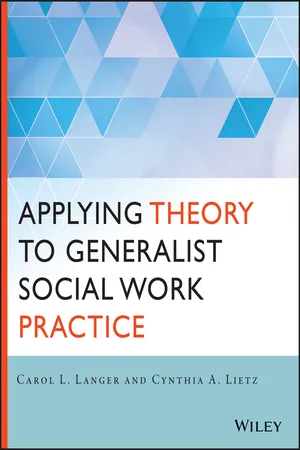
- English
- ePUB (mobile friendly)
- Available on iOS & Android
Applying Theory to Generalist Social Work Practice
About this book
The social worker's guide to integrating theory and practice
Applying Theory to Generalist Social Work Practice teaches aspiring social workers how to apply theory in real world practice. Fully aligned with the Council on Social Work Education's 2015 Educational Policy and Accreditation Standards, the book links theory to practice with clear, concise instruction including a discussion of evidence-based practice. Twelve commonly-used theories are thoroughly explained, with discussion of the strengths and limitations of each, and applied to real work with individuals, groups, families, communities, and organizations. The book includes case studies and first-person contributions from practicing social workers to illustrate the real-world scenarios in which different concepts apply. Critical thinking questions help students strengthen their understanding of the ideas presented. Tools including a test bank, PowerPoint slides, and an instructor's manual are available to facilitate classroom use, providing a single-volume guide to the entire helping process, from engagement to termination.
Practice is a core foundational course for future social workers, but many practice texts focus on skills while neglecting the theoretical basis for social work. Applying Theory to Generalist Social Work Practice fills that gap by covering both skills and theory in a single text.
- Examines the applications of prevailing social theories
- Covers the most common theories used in micro, mezzo, and macro practice
- Helps readers understand well-established approaches like strengths perspective, humanistic and client-centered, task-centered, and solution-focused brief therapy
- Shows how to apply major theories including ecological/system, cognitive/behavioral, conflict, empowerment, narrative, crisis, critical, and feminist
An effective social worker recognizes the link between theory and practice, and how the two inform each other to culminate in the most effective intervention and most positive outcome for the client. Applying Theory to Generalist Social Work Practice provides students with a roadmap to the full integration of philosophy and application in social work.
Frequently asked questions
- Essential is ideal for learners and professionals who enjoy exploring a wide range of subjects. Access the Essential Library with 800,000+ trusted titles and best-sellers across business, personal growth, and the humanities. Includes unlimited reading time and Standard Read Aloud voice.
- Complete: Perfect for advanced learners and researchers needing full, unrestricted access. Unlock 1.4M+ books across hundreds of subjects, including academic and specialized titles. The Complete Plan also includes advanced features like Premium Read Aloud and Research Assistant.
Please note we cannot support devices running on iOS 13 and Android 7 or earlier. Learn more about using the app.
Information
Chapter 1
The Role of Theories in Social Work Practice
Chapter One Core Competencies
- Students will understand the process of evidence-based decision making and learn the importance of thinking critically about theories.
- Students will understand the importance of developing therapeutic, professional relationships with clients regardless of the theoretical approach chosen.
- Students will be able to define the common elements that are essential to a practice regardless of the theory that is used to inform practice.
- Students will be able to identify various models used when integrating theories in practice.
- Students will be able to think critically about the advantages and disadvantages of taking an eclectic approach.
- Students will be able to define basic and advanced microskills and understand how microskills are used to implement interventions on micro-, mezzo-, and macrosystem practice levels.
Introduction
What Is Theory?
| Level | Strengths | Limitations | Examples |
| Practice Perspectives |
|
|
|
| Practice Theories |
|
|
|
| Practice Models |
|
|
|
| Theory | An organized set of ideas that seek to explain a particular phenomenon |
| Empirical Evidence | Evidence based on what can be observed through the five senses |
| Mechanism for Change | An explanation regarding the process for making positive improvements regarding a particular problem |
| Evidence-Based Practice | A process of choosing an intervention based on the best available research evidence, a social worker’s judgment, and a client’s personal and cultural preferences |
| Microskills | Elements in communication such as asking questions or reflecting feelings that help a professional to facilitate a social work interview |
Table of contents
- Cover
- Title Page
- Copyright
- Introduction
- Chapter 1: The Role of Theories in Social Work Practice
- Chapter 2: Ecological and Systems Theories
- Chapter 3: The Strengths Perspective
- Chapter 4: The Task-Centered Model
- Chapter 5: Conflict Theory
- Chapter 6: Humanism and Client-Centered Theory
- Chapter 7: Cognitive and Behavioral Theories
- Chapter 8: Empowerment Theory
- Chapter 9: Narrative Theory
- Chapter 10: Solution-Focused Brief Therapy
- Chapter 11: Crisis Theory
- Chapter 12: Feminist and Critical Theories
- Chapter 13: Transtheoretical Model
- Chapter 14: Theory and Practice: Pulling It All Together
- Acknowledgments
- About the Authors
- Author Index
- Subject Index
- End User License Agreement